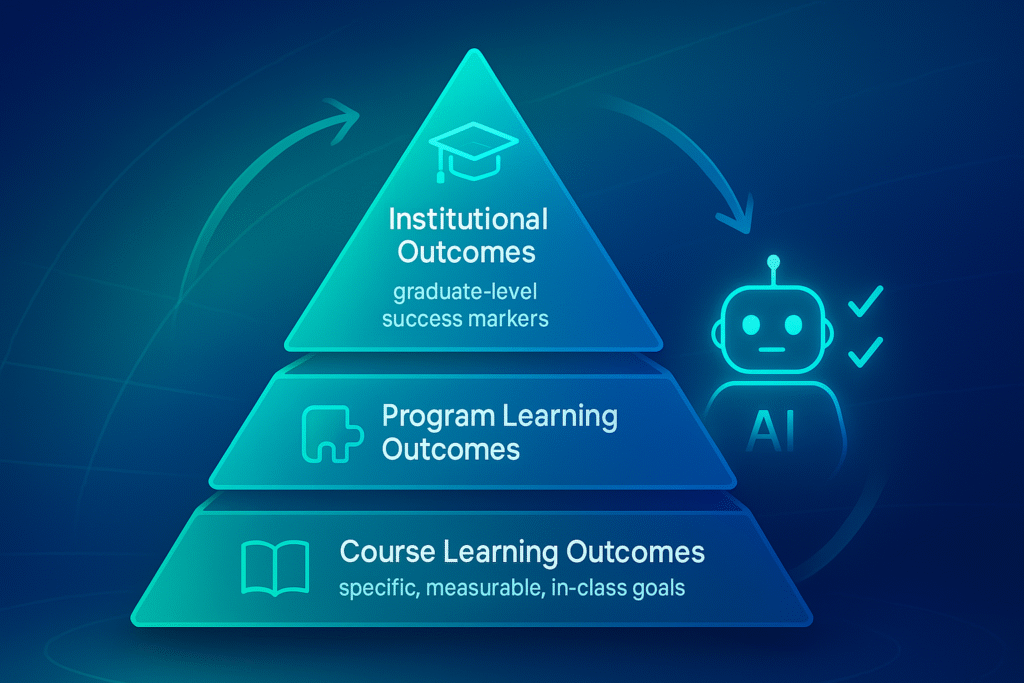
🌱 From Outcomes to Impact: Writing Program Learning Outcomes That Actually Work
Why words matter in assessment (and how AI can help sharpen them)
Introduction
We’ve all seen Program Learning Outcomes (PLOs) or Course Learning Outcomes (CLOs) that sound inspiring… but leave faculty, students, and accreditors scratching their heads. “Students will demonstrate leadership.” Lovely sentiment, but what does that mean in practice? Writing strong outcomes is an art and a science. This week, we’ll explore frameworks like Bloom’s Taxonomy and Fink’s Significant Learning framework, along with how Large Language Models (LLMs) can serve as editors, spot weaknesses, and suggest refinements. Strong outcomes don’t just live on paper—they drive teaching, learning, and student success.
Best Practices & Tips for Writing Strong Learning Outcomes
- 🎯 Use action verbs, not vague verbs: Avoid “understand” or “appreciate.” Use Bloom’s verbs like analyze, design, critique, propose.
- 📐 Apply multiple frameworks: Bloom’s is excellent for cognitive complexity, but Fink’s framework reminds us to also value caring, integration, and human dimensions.
- 🔁 Check alignment systematically: CLOs should map upward to PLOs, which map to institutional outcomes. Misaligned outcomes lead to “orphaned” assessments.
- 🤖 Use AI as a diagnostic buddy: An LLM can flag outcomes that are too broad, too low-level, or not measurable. For instance, it might suggest rewriting “Students will know ethics” to “Students will apply ethical reasoning to resolve discipline-specific dilemmas.”
- 🧩 Keep the system in mind: System thinking ensures outcomes don’t just live at the course level. Each should contribute meaningfully to program goals and, ultimately, student success.
Case Illustration: Revamping Business Program PLOs
The problem: A mid-sized university’s business program had accreditation concerns. Their PLOs read:
- “Students will demonstrate leadership.”
- “Students will understand global business.”
- “Students will be effective communicators.”
Faculty, students, and reviewers all asked: How do we measure “demonstrate” or “understand”?
The redesign process:
- Framework Review: A cross-functional faculty team revisited Bloom’s Taxonomy and Fink’s framework. They realized outcomes were stuck at the “understand” level and ignored affective/caring dimensions.
- Rewrite with Clarity: With help from an LLM, outcomes were refined:
- “Students will analyze leadership theories and apply them in team-based projects.”
- “Students will evaluate global business challenges and propose culturally informed solutions.”
- “Students will design and deliver professional business presentations using data visualization.”
- Mapping and Alignment: CLOs from courses like Organizational Behavior and Global Markets were revised to align with the new PLOs.
- Assessment Integration: Rubrics were updated. Capstone projects measured leadership and global awareness. Oral presentations were scored using clear communication rubrics.
- System Thinking: The changes flowed up to program review dashboards, showing how course-level data rolled into program outcomes.
Results:
- Faculty reported increased confidence in teaching to outcomes.
- Students felt clearer about expectations and pathways to success.
- The accrediting body praised the clarity and measurability of the outcomes.
- Predictive modeling later showed improved student persistence in advanced courses, particularly those tied to newly measurable skills.

Closing Thoughts
Good intentions don’t make strong outcomes—clarity, alignment, and measurability do. Frameworks like Bloom’s and Fink’s keep us grounded, while AI tools can highlight blind spots and offer suggestions we might miss. Strong outcomes build strong programs, and strong programs build strong graduates.
Next week, we’ll tackle Survey Design in Higher Education: How to move from “just another survey” to one that produces valid, reliable, and actionable insights. We’ll dig into everything from framing research questions to pilot testing.
❓ Question of the Week
Look at one of your current CLOs or PLOs. Would a student reading it know exactly what skill or behavior they’re expected to demonstrate? If not, how might you rewrite it using a stronger action verb?

